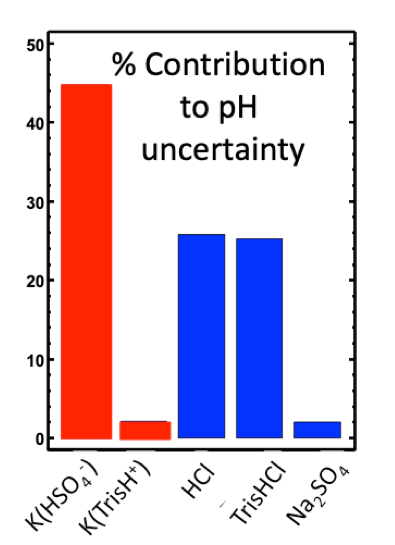By Simon Clegg and Matthew Humphreys (UEA)
Members of a funded NERC/NSF project A Thermodynamic Chemical Speciation Model for the Oceans, Seas, and Estuaries are working to develop new tools for the calculation of chemical speciation in seawater and other natural waters. After seeking feedback from the oceanographic community via a Town Hall at the 2016 Ocean Sciences Meeting and an online survey, Matthew Humphreys and Simon Clegg at the University of East Anglia (UK) are developing a draft software package that will be able to:
- Adjust the stability constants for the ocean carbonate system for deviations of water composition from seawater stoichiometry
- Make similar adjustments for composition effects on pH, and on the buffer used to define the total pH scale
- Quantify the effects of the ionic components of natural waters on equilibrium constants and pH and subsequently identify those chemical systems for which new measurements are needed in order to improve the accuracy of predictions

Calculations for Tris pH buffer in S = 35 artificial seawater, showing that the largest contribution to the total uncertainty in pHT (±0.007, calculated using a speciation model) is from the thermodynamic equilibrium constant for bisulfate (HSO4-) dissociation. This is followed by the influence of Cl- on H+ ions (HCl), and on TrisH+ ions (TrisHCl). The uncertainty contributions of the TrisH+ equilibrium constant, and Na+ interactions on SO42- are both small.
This work is part of a larger effort by members of Scientific Committee on Oceanic Research (SCOR) Working Group 145 to inform and facilitate the development of chemical speciation models that quantify uncertainties and are applicable across a broader range of natural waters.
Participants of this project and SCOR Working Group 145 (Matthew Humphries, Simon Clegg, David Turner, Andrew Dickson, Heather Benway) will attend the 2020 Ocean Sciences Meeting in San Diego and provide several opportunities to share new scientific results on chemical speciation and showcase the new speciation model. You can learn more as follows:
- View presentations of our methods and initial results in session CT003 – Chemical Speciation and Biogeochemistry in a Changing Ocean (abstracts due Sept. 11)
- Participate in a hands-on demonstration of our draft tools for speciation calculations at a special workshop side event (more details will be provided via the OCB, SCOR, and GEOTRACES email lists/websites)
- Visit the SCOR exhibit booth (booth 341 in the exhibit hall) to chat and work one-on-one with the speciation model on a dedicated PC




